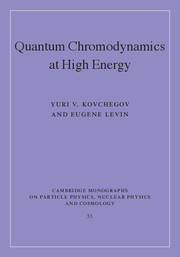Book contents
- Frontmatter
- Contents
- Preface
- 1 Introduction: basics of QCD perturbation theory
- 2 Deep inelastic scattering
- 3 Energy evolution and leading logarithm-1/x approximation in QCD
- 4 Dipole approach to high parton density QCD
- 5 Classical gluon fields and the color glass condensate
- 6 Corrections to nonlinear evolution equations
- 7 Diffraction at high energy
- 8 Particle production in high energy QCD
- 9 Instead of conclusions
- Appendix A Reference formulas
- Appendix B Dispersion relations, analyticity, and unitarity of the scattering amplitude
- References
- Index
1 - Introduction: basics of QCD perturbation theory
- Frontmatter
- Contents
- Preface
- 1 Introduction: basics of QCD perturbation theory
- 2 Deep inelastic scattering
- 3 Energy evolution and leading logarithm-1/x approximation in QCD
- 4 Dipole approach to high parton density QCD
- 5 Classical gluon fields and the color glass condensate
- 6 Corrections to nonlinear evolution equations
- 7 Diffraction at high energy
- 8 Particle production in high energy QCD
- 9 Instead of conclusions
- Appendix A Reference formulas
- Appendix B Dispersion relations, analyticity, and unitarity of the scattering amplitude
- References
- Index
Summary
Quantum chromodynamics (QCD) is the theory of strong interactions. This is an exciting physical theory, whose Lagrangian deals with quark and gluon fields and their interactions. At the same time, quarks and gluons do not exist as free particles in nature but combine into bound states (hadrons) instead. This phenomenon, known as quark confinement, is one of the most profound puzzles of QCD. Another amazing feature of QCD is the property of asymptotic freedom: quarks and gluons tend to interact more weakly over short distances and more strongly over longer distances.
This book is dedicated to another QCD mystery: the behavior of quarks and gluons in high energy collisions. Quantum chromodynamics is omnipresent in high energy collisions of all kinds of known particles. There are vast amounts of high energy scattering data on strong interactions, which have been collected at accelerators around the world. While these data are incredibly diverse they often exhibit intriguingly universal scaling properties, which unify much of the data while puzzling both experimentalists and theorists alike. Such universality appears to imply that the underlying QCD dynamics is the same for a broad range of high energy scattering phenomena.
The main goal of this book is to provide a consistent theoretical description of high energy QCD interactions. We will show that the QCD dynamics in high energy collisions is very sophisticated and often nonlinear. At the same time much solid theoretical progress has been made on the subject over the years.
- Type
- Chapter
- Information
- Quantum Chromodynamics at High Energy , pp. 1 - 21Publisher: Cambridge University PressPrint publication year: 2012



